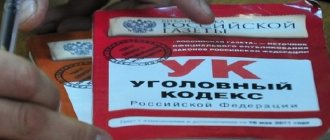Commentary to Art. 36 Criminal Code
1. The excess of the perpetrator is understood as the commission by the perpetrator of a crime that is not covered by the intent of the other accomplices.
2. In case of qualitative excess, the perpetrator commits a crime that goes beyond the scope of his conspiracy with other accomplices and is not the same as what was planned to be committed. Such a crime is committed either in addition to what was planned and committed, or in place of what was planned. In the first case, accomplices are liable only for the completed crime covered by their intent; in the second - for a crime covered by their intent, but according to the rules about an unfinished crime.
3. Quantitative excess is characterized by the perpetrator’s deviation from the crime initially intended to be committed in terms of its severity. In this case, the accomplices are held liable for the completed crime covered by their intent without qualifying features.
Differences
Complicity is different from involvement in a crime. Involvement is a situation in which a person’s actions are not in a causal relationship with the behavior of accomplices pursuing the goal of achieving a result. Touch has the following types:
Non-reporting is the failure to notify the relevant authorities that an illegal act is being prepared or has been committed. Non-reporting is characterized by signs of passivity and lack of data.
Connivance is failure to interfere with a crime. Connivance is characterized by inaction, since it takes place during the commission of a crime.
Concealment - can be carried out in relation to a person, funds, instruments of a criminal act, objects obtained by criminal methods. Concealment, even if it was not discussed and prepared in advance, is a crime in relation to guilty acts classified as especially serious.
Second commentary to Art. 36 of the Criminal Code of the Russian Federation
1. According to the law, the excess of a perpetrator is the commission by the perpetrator of a crime that is not covered by the intent of other accomplices. There are quantitative and qualitative excesses.
With quantitative excess, a more dangerous, but similar to the original crime is committed. For example, instead of a theft planned with other accomplices, the perpetrator commits theft on an especially large scale. In case of qualitative excess, the perpetrator commits another heterogeneous crime instead of the original crime or in addition to it. For example, instead of a theft planned with other accomplices with illegal entry into a home, the perpetrator commits murder involving robbery.
Responsibility for the excesses of the perpetrator lies only with the perpetrator himself; other accomplices in the crime are responsible only for the act that was covered by their intent.
The Constitutional Court clarified the issue of qualification of a crime in case of excess of the perpetrator
On April 11, the Constitutional Court issued Ruling No. 862-O, in which it addressed the issue of qualifying a crime committed in complicity with the excesses of the perpetrator.
As follows from the definition, S., T. and a third party not identified by the investigation, with the aim of stealing the property of the company, arrived at its fenced territory, where T. remained to observe the surrounding situation. Having entered the territory, S. and the third accomplice began to take out copper bars, but were discovered by an employee of the company, I., who demanded to stop the illegal actions. An accomplice, not identified by the investigation, pointed a pneumatic gas pistol at I., ordered him to raise his hands and not move, threatening to use violence. After this, the accomplices took possession of the copper tires and fled with the stolen property, subsequently disposing of it at their own discretion.
A criminal case charging S. and T. with committing crimes, including those provided for in Part 3 of Art. 162 of the Criminal Code, namely robbery committed by a group of persons by prior conspiracy with the threat of violence dangerous to life or health, with the use of objects used as weapons, and with illegal entry into the premises or other storage facility was sent to the Traktorozavodsky District Court of the city. Chelyabinsk.
Having considered the materials of the criminal case, the court suspended the proceedings and decided to send the request to the Constitutional Court. He asked to check whether the Constitution complies with Part 2 of Art. 35 and part 2 of Art. 162 of the Criminal Code insofar as on their basis the issue of criminal liability for robbery committed by a group of persons by prior conspiracy is resolved (despite the fact that S. and T. were charged with robbery under Part 3 of Article 162 of the Criminal Code, the named qualifying feature is provided its part 2, which is the subject of the appeal). According to the applicant, these norms, in the meaning given to them by the official interpretation and established law enforcement practice, establish for persons who have previously agreed to commit theft other (different) conditions of criminal liability in the event that one of the co-perpetrators went beyond the limits of joint intent and committed actions , subject to legal assessment as robbery, and other members of the group continued their participation in the crime, using violence used by the co-perpetrator or the threat of its use to seize property or retain property.
The Constitutional Court noted that, enshrining in Ch. 21 of the Criminal Code constitutes crimes against property, the legislator included robbery among them, i.e., according to Part 1 of Art. 162 of this Code, an attack for the purpose of stealing someone else’s property, committed with the use of violence dangerous to life or health, or with the threat of such violence. Differentiating (strengthening) responsibility in Part 2 of the same article for robbery committed by a group of persons by prior conspiracy, as well as with the use of weapons or objects used as weapons, he did not go beyond the limits of his discretionary powers, but, on the contrary, took into account the increased the public danger of robbery due to changes in the method of committing this crime and its subject composition.
At the same time, the Court pointed out, considered in conjunction with the provisions of Art. 5, 8, 25, 32, 35 of the Criminal Code and paragraph 1 of the notes to Art. 158 of the Criminal Code, which qualifies the sign of robbery in the form of its commission by a group of persons by prior conspiracy, can be established by the court and entail stricter liability only when this act is committed by persons who have agreed in advance to jointly commit a crime and acted with direct intent aimed at unlawful gratuitous seizure or treatment someone else's property for the benefit of the perpetrator or other persons, causing damage to the owner or other holder of this property.
The Constitutional Court referred to Resolution of the Plenum of the Supreme Court of December 27, 2002 No. 29 “On judicial practice in cases of theft, robbery and robbery”, where it explained that in cases where a group of persons previously agreed to commit the theft of someone else’s property, but who - one of the co-perpetrators went beyond the limits of the conspiracy, committing actions that are subject to legal assessment as robbery or robbery; what he did should be qualified under the relevant paragraphs and parts of Art. 161 and 162 of the Criminal Code. If other members of the criminal group continued their participation in the crime, taking advantage of the violence used by the co-perpetrator or the threat of its use to seize the property of the victim or retain this property, they also bear criminal liability for robbery or robbery by a group of persons by prior conspiracy with the appropriate qualifying features (paragraph 2 paragraph 141). These clarifications do not limit the application of the general provisions on excess of the performer contained in Art. 36 of the Criminal Code.
The court noted that thereby Part 2 of Art. 162 of the Criminal Code - taking into account its place in the system of criminal legal regulation and the meaning given to it by law enforcement practice - involves assessing the act as robbery only for those accomplices who used physical or mental violence or used it to steal someone else’s property, i.e. . was aware of the fact of violence and the fact of encroachment on not one, but two or more objects of criminal legal protection. The same participants in a group of persons by prior conspiracy who continued to participate in the seizure or retention of someone else’s property, without realizing the change in the method of theft due to the excesses of other perpetrators, must be held accountable based on those signs of the crime that were covered by their intent.
“Consequently, part two of Article 35 and part two of Article 162 of the Criminal Code of the Russian Federation are designed to ensure the differentiation of criminal liability and the assignment to a person of a fair punishment corresponding to the nature and degree of social danger of the crime, only for those socially dangerous actions and socially dangerous consequences that have occurred in respect of which it is established his fault. Since, therefore, there is no uncertainty about the compliance of these norms with the Constitution of the Russian Federation in the aspect indicated in the request of the Traktorozavodsky District Court of the city of Chelyabinsk, this request cannot be accepted by the Constitutional Court of the Russian Federation for consideration,” the Constitutional Court indicated.
Commenting on the definition, Mikhail Kiriyenko, partner of the law firm "KRP", noted that the issues of qualification of crimes committed in complicity are traditionally debatable, both in the doctrine of criminal law and in law enforcement practice, therefore the appeal to them by the Constitutional Court certainly deserves attention. He pointed out that the Constitutional Court confirmed the importance of taking into account the subjective characteristics of both the corpus delicti and complicity.
Mikhail Kiriyenko noted that the request to the Constitutional Court refers to the so-called quantitative excess of the performer, which is assessed from the perspective of the provisions of Art. 35, 36 of the Criminal Code. The lawyer pointed out that the wording of clause 14.1 of the Resolution of the Plenum of the Supreme Court No. 29 contains a flaw that allows some law enforcement officials to distribute a change in the method of theft when it is committed by a group of persons as a circumstance that is automatically subject to imputation to all accomplices without exception, however, the Supreme Court does not say that that the awareness of the crime committed by each accomplice does not matter and that there is no need to take into account the degree of awareness of a particular person when qualifying.
“That is why the Constitutional Court of the Russian Federation made a very important clarification that those members of a group of persons by prior conspiracy who continued to participate in the seizure or retention of someone else’s property, without realizing the change in the method of theft due to the excesses of other perpetrators, should be held liable based on the signs of the crime that were covered their intent. This is what should remain the main guideline for law enforcement practice,” said Mikhail Kiriyenko.
Lawyer of the First Krasnoyarsk Regional Bar Association Dmitry Redkin noted that the Constitutional Court confirmed the legal position established and enshrined in the Resolution of the Plenum of the Supreme Court No. 29, according to which the transformation of the method of committing theft (from secret to open, or to an attack for the purpose of theft) in the event that obvious to all co-perpetrators, allows for the imputation of the qualifying characteristic “by a group of persons by prior conspiracy” in relation to all participants in the crime.
“Of course, one can debate how much this setting in the above-mentioned resolution correlates with the disposition of Part 2 of Art. 35 of the Criminal Code of the Russian Federation, which presupposes the existence of a preliminary conspiracy, i.e. an agreement to commit a crime reached in advance, before the implementation of its objective side. More accurate in the case of “flowing over” of theft into robbery or robbery in the case under consideration is the qualification of the latter as committed by a “group of persons” (Part 1 of Article 35 of the Criminal Code of the Russian Federation), but this qualifying feature is not included in Art. 161–162 of the Criminal Code of the Russian Federation,” said Dmitry Redkin.
Thus, the lawyer noted, the Constitutional Court maintained the existing status quo. “Perhaps the decision is not ideal from the point of view of “pure qualification”, but, of course, justified in terms of certainty of law enforcement,” he concluded.
Cause-and-effect relationships
Accomplices are exempt from punishment for the act committed by the perpetrator for the following reasons:
- the absence of a causal connection between the activities of the participants and the criminal result to which the actions of the perpetrator led;
- absence of intentional guilt as a result of the activities of two or more persons.
In case of excess, the liability of other accomplices is limited only to actions committed within the framework of the criminal agreement. Accomplices can only be responsible for those actions that they foresaw and to which they agreed. In this case, the perpetrator encroaches on another object or commits crimes other than those to which he was incited.
Involvement in crime
In criminal law there is such a definition as “involvement in a crime,” which differs from complicity, but at the same time has similar features. Thus, the actions of a person in this case may not have a causal connection with the act of accomplices, but there is some involvement in them. An example of touchiness is:
- non-reporting (non-reporting or passive behavior);
- connivance (inaction);
- harboring;
- acquisition or sale of property obtained by criminal means.
And complicity in a crime must certainly have a causal connection with the actions of other persons attempting an illegal act.
Performer excess in practice
Two young people, having learned about large savings in one of the households, decide to commit a robbery. They entered the house when only the guard was present. The man was tied up and threatened with a knife. One went in search of money. After the money was found and stolen, the second of the participants, not wanting to leave witnesses, kills the guard.
The court finds both participants guilty. But the court decision indicated that when committing the crime there was excess of the perpetrator. Therefore, the court of second instance overturned the previous verdict. The explanation states that the criminals agreed to use weapons only as an object of intimidation. Murder was not part of the criminals' plans. At the time of the crime, the second of the criminals was packing the stolen money and was in another room. The actions of the criminal, who did not commit murder, were reclassified, and he received a sentence for robbery.
Another example from judicial practice, which presents the qualitative excesses of the performer. Three criminals kidnapped a person for ransom. But the relatives of the kidnapped man refused to pay the money and said that they would report it to the police. After a conversation between Mondays, a scandal arises. In a fit of anger, one of the group members begins to beat the kidnapped man, as a result of which he dies.
During the trial, all members of the group received punishment for kidnapping. But the one who killed is punished for committing murder. Thus, he received a longer sentence than his two accomplices - this is the excess of the performer.
Quantitative kurtosis
Let us consider the excesses of the perpetrator of the crime. An example of this would be a situation where an instigator persuades a perpetrator to steal, and he then commits a robbery. These crimes are essentially homogeneous, but their degree of danger varies.
The instigator in this case is responsible for preparing for the theft, since he was engaged in an attempt on this particular crime, but due to circumstances beyond his control, namely the unforeseen actions of the perpetrator, another criminal act was committed, for which the person who did it.
That is, in this case, a more dangerous act was committed, since robbery is already a two-object crime directed against a person and property, while theft is a single-object crime.








